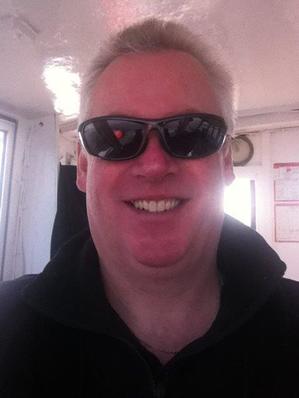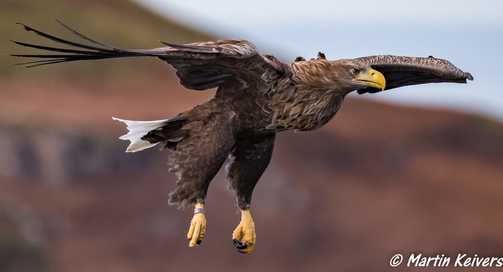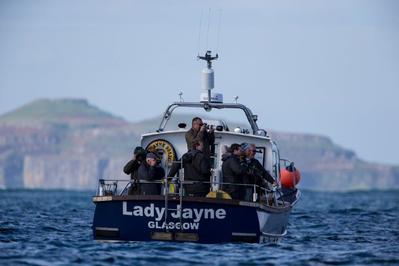|
4/4/2017 8 Comments Guest Blog – by Martin Keivers. Over the years I have been asked many questions.Martin Keivers speaks to Rewild Scotland and reflects on a 30 year relationship with White Tailed Sea Eagles.  Over the years I have been asked many questions. When people hear my accent for the first time it usually has the same effect and triggers their inquisitive side ‘’where are you from?’’ or ‘’that’s not a Scottish accent’’ are the favourite comments. For some reason it shocks people to find a renegade Yorkshireman living on the island of Mull and running boat trips to see the White Tailed Eagles. And I suppose I can see why, so let me tell you. When I first visited Mull as a young man in his twenties the very first breeding attempts for the eagles were just being made following the reintroduction programme which had started in 1975. Hunting and persecution had slowly and inexorably forced the last few of these magnificent birds to the furthest outposts of our islands where they were followed and exterminated. Thankfully as we progressed through the 20th century we began to miss these iconic and once revered birds and a plan to bring them back to their native home was hatched. The rest as they say is history but when I first visited Mull they were still extremely rare and knowledge of their whereabouts was a closely guarded secret.  When I eventually moved to Mull after falling head over heels in love with the island on that very first visit their presence was established and despite severe protestations from some quarters, they were here to stay. The first successful breeding season was in 1985 and since then the number of breeding pairs in the UK has increased year on year to the point where we reached 100 pairs on the 40th anniversary of their reintroduction. By any measure this would be a cause for celebration and it was heralded as a huge success by all those involved and rightly so too. It can never be easy though reintroducing an apex predator back into its previous home range. Whether right or wrong the birds were exterminated for a reason, and at that time it was supposed that they were a threat to humans and farm animals, especially lambs, who was to say that this wouldn’t be so with reintroduced birds. Well, thankfully as we progress as a species we have also learnt to look at the facts before making decisions (well some have!) Farmers in Norway where the young eaglets were imported from don’t have a problem with adult eagles taking lambs and the myths of eagles carrying infants off to their eyries was exactly that – just a myth. However as a race it seems we had soon forgotten how to live with these hungry birds as our neighbours. And the area into which these birds were being reintroduced had also changed, sometimes massively. Back in the early 21st century we boasted a massive fishing fleet both of offshore and inshore vessels and fish stocks weren’t even dented by our efforts. Farming here was mainly crofting and small scale subsistence farming, large scale hill farming of sheep wasn’t common. There were more people around, the recently abandoned villages we find and photograph are testament to that. There were no wind farms or mile after mile of deer fenced hills. The speed of vehicles on the single track roads would be 20mph at best and traffic rare, so how can we expect a species which has been absent for nearly 100 years to suddenly fit in with our modern methods and way of life? Well it has!  Those downy bewildered looking creatures which were so carefully brought from Norway by the RAF and looked after by a small group of dedicated people and eventually released into the wild sought out territories in which to build their nests and find mates from the few other sea eagles in this vast expanse of land and eventually raise young. They have adapted to the changed environment remarkably well even if they still have some of their inbuilt knowledge. They know if they see a flock of ravens or black backed gulls fighting on a hill side there will be something of interest for them too, so they go and investigate. Whether it is a dead rabbit from a buzzard kill or a lamb killed by a raven by pecking its eyes out at birth, to a white tailed eagle it is food and as the king of the skies it descends on the carcass and starts to feed. Of course the original owners of the carcass find this intrusion too much and try and chase the eagle away. After a while the eagle gets fed up and flies away, usually taking its stolen meal with it. So you can see how easy it would be to presume that every missing or dead lamb could be attributed to the eagles. The birds are far more likely to feed at a carcass or scavenge for their food than actively hunt prey themselves. Hunting is dangerous and expends lots of energy so why risk it, let another animal do all the hard work then go and steal its lunch. The birds also recognise that gulls following a fishing boat usually mean an easy meal of scraps or discarded fish. This was what gave the birds their common name of Sea Eagles as they were more commonly seen at sea than over land, principally because we had such a large fishing fleet back in the old days which would return to port each day cleaning the catch and throwing unwanted items overboard. This is exactly the inbred behaviour we utilised when we started our trips some 9 years ago. Of course now with the decline of fish stocks and the decimation of the local fishing fleet this is a practice that would not sustain a single bird let alone a population so wouldn’t ever be seen unless we re-created it on a daily basis. So how might you ask do I fit in with this story of extermination, changing times and reintroduction? I have always been a fisherman, even for a short time a commercial fisherman catching crabs, prawns and lobsters. On one occasion I was fly fishing an inland loch for brown trout and catching small fish on a fairly regular basis. This was on a loch which the famous Skye and Frisa had their territory, and one of them happened to be flying past me as I caught a fish. I suddenly went from being an insignificant lump of flesh and bone to the centre of this Eagles attention. A sharp bank around and the eagle was flying directly towards me watching as I reeled in the wriggling trout. I was gobsmacked at how close this eagle came to me and how curious it was of my fishing actions. Relating this tale to our local RSPB officer is what got me to thinking that maybe there was more to this reaction than I had initially thought. And so a plan was formed, hastily at first but after lengthy consultations with the powers that be and all the proper consents, and by making sure that we would be doing everything correctly and putting the welfare of the birds first at all time we were ready to go. At first we weren’t really sure how things would work out and we kept our activities low key. But the local eagles which had been nesting in our area for some years were very quick to catch on to the regular sight of the blue boat approaching them up the loch and it must have triggered some distant genetic memory and associated our appearance with food. Gradually over the following years our mutual trust has grown and we have come to know these intelligent birds as individuals as they have come to know us. Now if neither Alex or I are on deck the birds will look in through the wheelhouse window to seek us out. They also recognise the difference between our boat and the local creel boats which only catch prawns so they don’t waste energy visiting boats where there is no chance of a free fish. Over the years that I have lived on Mull I have seen the numbers of visitors increase year on year. Popular TV documentaries and personalities have raised the awareness of people to wildlife on a worldwide scale. When those people then find out that here on Mull we have resident the fourth largest eagle in the world (White Tailed Eagle) and Europe’s highest concentration of golden eagles together with hen harrier, short eared owls etc and a supporting cast of red deer, seals, otters and whales, then it is only a matter of time before they want to come and see them for themselves. Also digital photography has made capturing world class images within the reach of the ordinary person so photographers too want the best wildlife to photograph. All this together with Mulls wonderful scenery and laid back atmosphere has meant that Mull is so rightly considered the wildlife capital of the UK and draws in people from all over the world. I have been lucky that since my first visit to Mull all those years ago when white tailed eagles were so rare that I have seen their population grow and generate more and more interest and consequently generate a huge amount of income to a small Hebridean island over the intervening years. I suppose I have played my own small part as have so many others in making Mull the destination it now is and our B&B has a higher percentage of wildlife lovers than ever before. What we sincerely hope is that Mull doesn’t become a victim of its own success. While there is currently room for the annual influx of mostly well behaved visitors I would never want to see the island turned into a zoo or even a National Park. It is a unique environment where people and animals bump along now in relative harmony. There have been the odd instance of an eagle taking a lamb but farming practices are again adapting to having large predators about and help with indoor lambing is available to farmers who want it via government funded schemes. Sea and land based tour operators are plentiful and can help visitors greatly by saving them time looking for wildlife and educating them on how to observe or photograph wildlife in a responsible manner which is vital for the long term sustainability of Mull and its wildlife and those that depend on it. If I have a vision for the future it would be that all those living on this island appreciated just how much our wildlife means, not just as an income generator or a draw for visitors but as a long term resource that looked after properly will sustain our generations in years to come and provide joy to those that come to see it. Everyone on the island benefits from the increased number of ferries available in the summer time and many clubs and institutions benefit directly from the White tailed eagle watching hides run by a local partnerships including MICT, RSPB, SNH and local forest groups which support them financially on an annual basis. I am proud that my son has become the first and only dedicated otter guide on the island and now takes his clients to photograph these shy creatures, something that is extremely difficult without years of knowledge and practice. So if you ever wondered how a bloke with a Yorkshire accent came to be running eagle trips on Mull……. Author
8 Comments
4/4/2017 08:29:18 pm
Fantastic read Martin. Well done. We need a book now with your stories in.
Reply
Martin Keivers
5/4/2017 09:48:57 am
Thanks Helen, maybe when I hang my skippers cap up :-)
Reply
Andrea
6/4/2017 07:38:14 am
Great read Martin I always enjoy your ramblings, it reminds us of what we are missing on that wonderful Island and why we return year after year. More please!
Reply
Martin Keivers
24/4/2017 04:10:01 pm
Thank you Andrea, see you soon I hope
Reply
Mandy Tutchener
7/4/2017 05:54:13 pm
Excellent Martin, as we experienced wonderful trips with you and Alex in Lady Jayne, we know how much you love white tailed sea eagles and the Isle of Mull. You would write a great book, but please continue to share your knowledge with everyone on Lady Jayne.
Reply
Martin Keivers
24/4/2017 04:09:20 pm
Hi Mandy, thank you for the kind words, I will always remember the fishing trip that ended up being a dolphin watching trip - great fun
Reply
Martin Keivers
12/6/2017 12:49:56 pm
Thanks Mandy, glad you enjoy the read
Reply
Jean Baker
14/6/2022 11:01:56 am
Hi Martin,just to say what a wonderful afternoon myself and family spent last week(June),it was truly magical ,informative and great fun.
Reply
Leave a Reply. |
Alan Hepburn 2024 |
Twitter - twitter.com/RewildScotland
|

 RSS Feed
RSS Feed